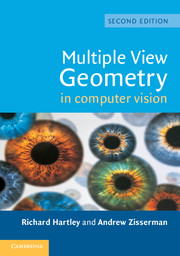Book contents
- Frontmatter
- Contents
- Foreword
- Preface
- 1 Introduction – a Tour of Multiple View Geometry
- PART 0 The Background: Projective Geometry, Transformations and Estimation
- PART I Camera Geometry and Single View Geometry
- PART II Two-View Geometry
- PART III Three-View Geometry
- PART IV N-View Geometry
- 17 N-Linearities and Multiple View Tensors
- 18 N-View Computational Methods
- 19 Auto-Calibration
- 20 Duality
- 21 Cheirality
- 22 Degenerate Configurations
- PART V Appendices
- Bibliography
- Index
21 - Cheirality
Published online by Cambridge University Press: 25 January 2011
- Frontmatter
- Contents
- Foreword
- Preface
- 1 Introduction – a Tour of Multiple View Geometry
- PART 0 The Background: Projective Geometry, Transformations and Estimation
- PART I Camera Geometry and Single View Geometry
- PART II Two-View Geometry
- PART III Three-View Geometry
- PART IV N-View Geometry
- 17 N-Linearities and Multiple View Tensors
- 18 N-View Computational Methods
- 19 Auto-Calibration
- 20 Duality
- 21 Cheirality
- 22 Degenerate Configurations
- PART V Appendices
- Bibliography
- Index
Summary
When a projective reconstruction of a scene is carried out from a set of point correspondences, an important piece of information is typically ignored – if the points are visible in the images, then they must have been in front of the camera. In general, a projective reconstruction of a scene will not bear a close resemblance to the real scene when interpreted as if the coordinate frame were Euclidean. The scene is often split across the plane at infinity, as is illustrated in two dimensions by figure 21.1. It is possible to come much closer to at least an affine reconstruction of the scene by taking this simple constraint into account. The resulting reconstruction is called “quasi-affine” in that it lies part way between a projective and affine reconstruction. Scene objects are no longer split across the plane at infinity, though they may still suffer projective distortion.
Converting a projective reconstruction to quasi-affine is extremely simple if one neglects the cameras and requires only that the scene be of the correct quasi-affine form – in fact it can be accomplished in about two lines of programming (see corollary 21.9). To handle the cameras as well requires the solution of a linear programming problem.
- Type
- Chapter
- Information
- Multiple View Geometry in Computer Vision , pp. 515 - 532Publisher: Cambridge University PressPrint publication year: 2004
- 1
- Cited by



